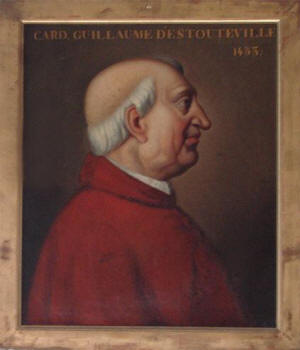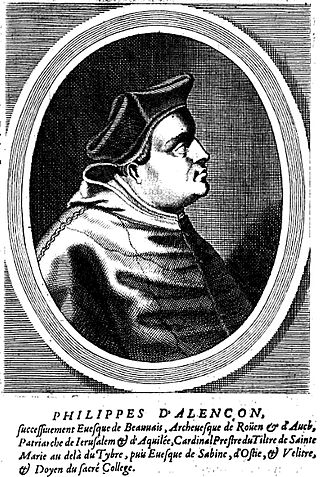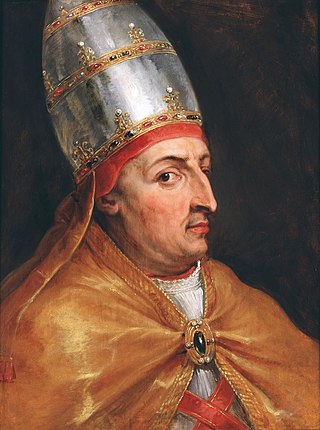This article relies largely or entirely on a single source .(May 2014) |
Guillaume-Hugues d'Estaing (died 28 October 1455) (called the Cardinal of Metz) was a French Roman Catholic cardinal and bishop.
This article relies largely or entirely on a single source .(May 2014) |
Guillaume-Hugues d'Estaing (died 28 October 1455) (called the Cardinal of Metz) was a French Roman Catholic cardinal and bishop.
Guillaume-Hugues d'Estaing was born in Étain, the son of Hugues d'Estaing. [1] After becoming a doctor of both laws, he entered the Order of Saint Benedict. [1] He was ordained as a priest and then became archdeacon of Verdun. [1] He later became archdeacon of Metz. [1]
He was in attendance at the Council of Basle (1431–43). [1] In 1437, he was a member of the conciliar commission that reported on the poor governance of the church by Pope Eugene IV. [1] In the papal conclave of 5 November 1439 he was one of the supporters of Antipope Felix V. [1]
Antipope Felix V made him a pseudocardinal on 6 April 1444 in Geneva, offering him the titular church of San Marcello al Corso. [1] Estaing refused Felix V's offer to make him a cardinal, instead choosing to side with Pope Nicholas V, who absolved him for his earlier support of Felix. [1] In the consistory of 19 December 1449, Nicholas V made Estaing a cardinal priest, awarding him the titular church of Santa Sabina on 12 January 1450. [1] Estaing entered Rome on 30 November 1450 and received the red hat the next day. [1]
On 1 March 1451, he was elected Bishop of Sion, though a dispute with the cathedral chapter ultimately led to his resignation as bishop on 11 September 1454. [1] He was present at the secret consistory of 27 October 1451. [1] He served as Camerlengo of the Sacred College of Cardinals from November 1452 to 5 November 1453. [1] On 27 June 1453, he was elected Bishop of Fréjus, holding this position until his death. [1] He participated in the papal conclave of 1455 which elected Pope Callixtus III. [1]
He died in Rome on 28 October 1455. [1] He is buried in Santa Sabina. [1]
Louis Aleman was a French Roman Catholic cardinal and a professed member of the now-suppressed Canons Regular of Saint John Baptist. He served as the Archbishop of Arles from 1423 until his resignation in 1440 when he had resigned from the cardinalate. But he was later reinstated as a cardinal on 19 December 1449 at which point he served as the Protopriest and also reclaimed his titular church.

Guillaume d'Estouteville was a French aristocrat of royal blood who became a leading bishop and cardinal. He held a number of Church offices simultaneously. He conducted the reexamination of the case of Jeanne d'Arc and exonerated her of the charges against her. He reformed the Statutes of the University of Paris. In Rome he became one of the most influential members of the Curia, as the official Protector of France in church business. Pope Sixtus IV appointed him Chamberlain of the Holy Roman Church (Camerlengo). His great wealth allowed him to be a generous patron of the arts, especially in the building and adornment of churches.

Giorgio Fieschi was an Italian cardinal, of the counts of Lavagna.
Alain (II) de Coëtivy was a prelate from a Breton noble family. He was bishop of Avignon, Uzès, Nîmes and of Dol, titular cardinal of Santa Prassede, then cardinal-bishop of Palestrina and cardinal-bishop of Sabina. Many sources mention him as the Cardinal of Avignon.
Prospero Colonna was a cardinal-nephew of Pope Martin V, whose election ended the Western Schism. Colonna was excommunicated for a period due to his rebellion against Martin V's successor, Pope Eugene IV, becoming one of the few excommunicated cardinals. Despite this, Colonna was the leading candidate to succeed Eugene IV in the papal conclave, 1447, where he was two votes away from election for the first three days.

Philip of Alençon was a French cardinal who was a member of the Valois dynasty. He was the second son of Count Charles II of Alençon, who was killed in the Battle of Crécy, and of Maria de La Cerda y de Lara. He was the younger brother of Count Charles III of Alençon.

Pope Nicholas V created eight new cardinals in three consistories, including the former Antipope Felix V (1439–1449). He also confirmed the three promotions made by this antipope, and restored two cardinals who were created by the legitimate popes but then deposed for having supported the schism of the Council of Basle and Antipope Felix V.

Antonio Cerdà i Lloscos was a Spanish Roman Catholic bishop and cardinal.
Jean d'Arces (1370s–1454) was a French Roman Catholic bishop and cardinal.

Louis de La Palud was a French Roman Catholic bishop and cardinal.
Giovanni Castiglione (1420–1460) was an Italian Roman Catholic bishop and cardinal.

Richard Olivier de Longueil (1406–1470) was a French Roman Catholic bishop and cardinal.

Berardo Eroli (1409–1479) was an Italian Roman Catholic bishop and cardinal.

Bartolomeo Roverella (1406–1476) was an Italian Roman Catholic bishop and cardinal.

Pedro Ferris (1416–1478) was a Spanish Roman Catholic bishop and cardinal.
Joan Margarit i Pau, or in Spanish Juan Margarit y Pau, was a prominent Catalan prelate, a bishop of Girona and a cardinal.
Juan López was a Spanish Roman Catholic bishop and cardinal.
René de Prie (1451–1519) was a French Roman Catholic bishop and cardinal.
Pope Eugene IV (1431–1447) created 27 cardinals in six consistories.

Filippo Spinola was an Italian Roman Catholic bishop and cardinal.